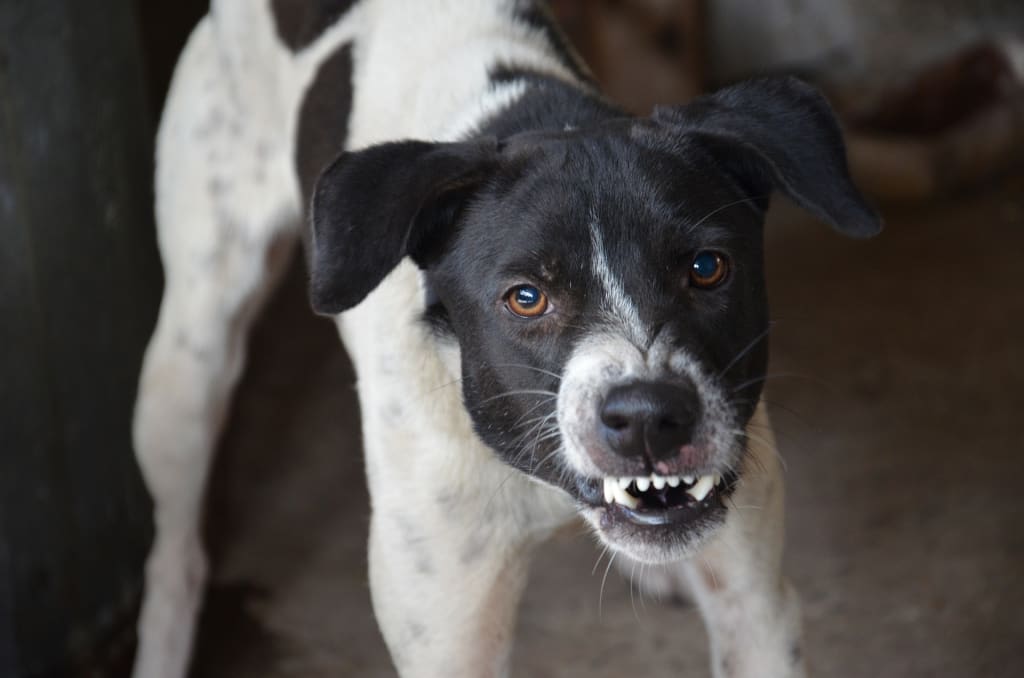5 Ways You May Be Making Your Dog More Aggressive Without Realizing
Avoiding these common mistakes will make your dog happier -- and safer.

Canine companions have become an integral part of many families. With the joy dogs can bring into our lives, it is easy to forget that they can also be potentially dangerous. If your dog is displaying aggressive behaviors, it is time to take a close look at its environment. If you don’t fully understand your dog’s needs, you may inadvertently be treating your dog in ways that are causing its aggression.
What is Dog Aggression?
It is normal for dogs to bark and play, but if yours is behaving dangerously towards people and other animals, it may have an aggression issue. Behaviors such as lunging, snarling and biting are warning signs that something is amiss.
What Causes Dog Aggression?
Dogs never attack for “no reason.” When a dog lashes out, it is usually a response to insecurity or fear. However, pain and mistreatment can also cause a dog to display aggressive behaviors, as can protective or territorial instincts.
Why Should You Care if Your Dog Is Aggressive?
While some people may feel safer with an aggressive dog to protect them, a dog that regularly displays threatening behaviors is a risk. First of all, this is a warning sign that a dog is not feeling safe and secure in its home. Secondly, the dog could be a danger to people and other pets the dog encounters, especially if it is a breed with high damage potential. Insurance companies use the potential damage a canine can cause when evaluating breeds. So while chihuahuas are known as one of the most aggressive breeds, their small size means they have low damage potential.
In addition, if your dog bites someone, you could be liable for legal damages. Dog bite laws vary by state, but many have strict liability, which means that the owner can be held responsible whether or not the bite can be shown to be caused by their negligence. Even if the dog was leashed, in the yard, or has never bitten anyone before, the owner may have to pay for the medical expenses and lost wages of the victim. In some states, such as Florida, this liability can be reduced if it can be shown the dog was provoked, or if the owner had warning signs displayed at the time of the attack.
5 Ways You May Be Making Your Dog More Aggressive Without Realizing
1. Isolating Your Dog
It is common for people to want to isolate a dog when it is showing signs of aggression, but this just makes the dog feel more afraid and insecure. While your dog should have a place they can retreat to when they want to be alone, locking it up regularly for extended periods is stressful and may make the aggression worse. Tying your dog down alone in the yard--where they don’t know why they can’t get to things or get away--is frustrating and frightening, and can cause aggression in even normally behaving dogs.
2. Poorly Socializing Your Dog
While the first few months are the most critical period in dog development, proper socialization practices will benefit your dog throughout its lifetime. Keep in mind that correcting negative behavior in an older dog who has never been socialized can be more difficult than properly socializing a puppy from a young age. You can’t force an already fearful dog to be social by taking it to a crowded place, as this could make their behavior worse.
Dogs need structure and routine to feel safe and secure, and it is their owner’s responsibility to provide that. Having a predictable schedule for meals, walks, and other activities in the dog’s daily life can help lessen the anxiety caused when they encounter unfamiliar sights, sounds, smells, animals, or people.
3. Letting Children Play With Your Dog Too Aggressively
Young children have a tendency to play roughly with animals, and it is important to prevent them from hurting or cornering your dog. Putting their faces close to the dog’s face is especially problematic, as canines interpret that as a challenge. Even if your dog seems to be tolerating a child’s antics, it may eventually become so stressed that it snaps in defense. When children are playing with your dog, it is important to be watching its body language for signs of distress.
4. Not Understanding Dog Body Language
Your dog is communicating with you all the time, but you won’t know what it is saying if you don’t know how to read canine body language. For instance, many people just see a wagging tail and assume that means the dog is happy, but it is more complicated than that. Wagging is a sign of emotional arousal, and you will have to take other cues such as the height of the tail into account in order to know what emotion they are expressing. Warning signs that your dog is stressed and may react aggressively include a low tail, ears turned back, or the body lowered towards the ground.
5. Improper Punishment/Training
Isolation, starvation and physical violence should never be used to discipline your dog, and will likely make it even more aggressive. Keep in mind that canines greeting each other while leashed is already unnatural behavior, and forcing your dog to do so head-on or while lying on the ground in front of the other dog will make it feel even more trapped. Managing dog aggression is about reinforcing desirable behaviors and calming the dog. Getting excited and yelling when a dog misbehaves has the potential to encourage the behavior you’re trying to avoid.
How to Seek Help for an Aggressive Dog
If your dog bites someone, you want to make sure to keep it on a leash and keep it away from contact with visitors for a time. Yet it is important to not isolate the dog or interrupt its daily routine, or you may make the situation worse. Make sure your dog is still getting walks, play time, and affection, even if you need to muzzle it.
Remember that various circumstances can cause any canine to become aggressive, and working on building more safety and security in your dog’s life can improve their behavior and prevent a future attack. It is recommended to seek help from a dog training professional or even a veterinarian if you need help with your dog’s behavior issues. A professional can evaluate your dog and their specific living situation to determine the root cause and best solution.






Comments
There are no comments for this story
Be the first to respond and start the conversation.